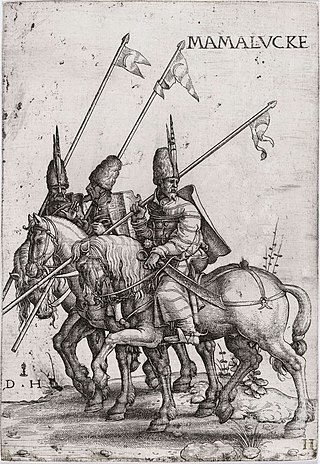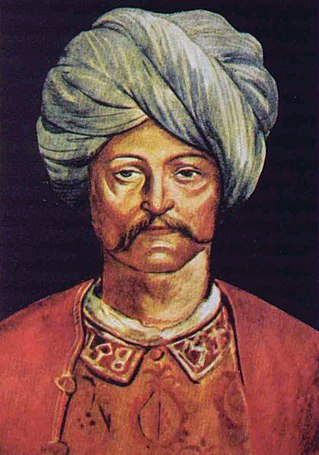
Bayezid II was the sultan of the Ottoman Empire from 1481 to 1512. During his reign, Bayezid consolidated the Ottoman Empire, thwarted a pro-Safavid rebellion and finally abdicated his throne to his son, Selim I. Bayezid evacuated Sephardi Jews from Spain following the fall of the Nasrid Kingdom of Granada and the proclamation of the Alhambra Decree and resettled them throughout Ottoman lands, especially in Salonica.

Lorenzo di Piero de' Medici, known as Lorenzo the Magnificent, was an Italian statesman, the de facto ruler of the Florentine Republic, and the most powerful patron of Renaissance culture in Italy. Lorenzo held the balance of power within the Italic League, an alliance of states that stabilized political conditions on the Italian Peninsula for decades, and his life coincided with the mature phase of the Italian Renaissance and the golden age of Florence. As a patron, he is best known for his sponsorship of artists such as Botticelli and Michelangelo. On the foreign policy front, Lorenzo manifested a clear plan to stem the territorial ambitions of Pope Sixtus IV, in the name of the balance of the Italic League of 1454. For these reasons, Lorenzo was the subject of the Pazzi conspiracy (1478), in which his brother Giuliano was assassinated. The Peace of Lodi of 1454 that he supported among the various Italian states collapsed with his death. He is buried in the Medici Chapel in Florence.

Pope Innocent VIII, born Giovanni Battista Cybo, was head of the Catholic Church and ruler of the Papal States from 29 August 1484 to his death, in July 1492. Son of the viceroy of Naples, Cybo spent his early years at the Neapolitan court. He became a priest in the retinue of Cardinal Calandrini, half-brother to Pope Nicholas V (1447–55); Bishop of Savona under Pope Paul II; and with the support of Cardinal Giuliano Della Rovere he was made a cardinal by Pope Sixtus IV. After intense politicking by Della Rovere, Cybo was elected pope in 1484. King Ferdinand I of Naples had supported Cybo's competitor, Rodrigo Borgia. The following year, Pope Innocent supported the barons in their failed revolt.

Year 1512 (MDXII) was a leap year starting on Thursday of the Julian calendar.

Mamluk or Mamaluk were non-Arab, ethnically diverse enslaved mercenaries, slave-soldiers, and freed slaves who were assigned high-ranking military and administrative duties, serving the ruling Arab and Ottoman dynasties in the Muslim world.

Cem Sultan or Sultan Cem or Şehzade Cem, was a claimant to the Ottoman throne in the 15th century.

Sultan Abu Al-Nasr Sayf ad-Din Al-Ashraf Qaitbay was the eighteenth Burji Mamluk Sultan of Egypt from 872 to 901 A.H.. He was Circassian by birth, and was purchased by the ninth sultan Barsbay before being freed by the eleventh Sultan Jaqmaq. A pious Sultan, he stabilized the Mamluk state and economy, consolidated the northern boundaries of the Sultanate with the Ottoman Empire, engaged in trade with other contemporaneous polities. Founding numerous religious buildings and endowing them with hundreds of waqfs, Qaitbay emerged as a great patron of art and architecture. In fact, although Qaitbay fought sixteen military campaigns, he is best remembered for the spectacular building projects that he sponsored, leaving his mark as an architectural patron on Mecca, Medina, Jerusalem, Damascus, Aleppo, Alexandria, and every quarter of Cairo.

The Burji Mamluks or Circassian Mamluks, sometimes referred to as the Burji dynasty, were the rulers of the Mamluk Sultanate of Egypt from 1382 until 1517. As with the preceding Bahri Mamluks, the members of the Burji Mamluk ruling class were purchased as slaves (mamluks) and manumitted, with the most powerful among them taking the role of sultan in Cairo. During this period, the ruling Mamluks were generally of Circassian origin, drawn from the Christian population of the northern Caucasus. The name Burji, meaning 'of the tower', refers to the traditional residence of these Mamluks in the barracks of the Citadel of Cairo.

Al-Ashraf Qansuh al-Ghuri or Qansuh II al-Ghawri was the second-to-last of the Mamluk Sultans. One of the last and most powerful of the Burji dynasty, he reigned from 1501 to 1516.

Francesco Berlinghieri (1440–1501) was a Florentine scholar and humanist who lived during the fifteenth century. He promoted the value of classical Greek learning and was one of the first to print a text based on Ptolemy's Geography. Berlinghieri studied poetry under the tutelage of Cristoforo Landino.

The Enchantress of Florence is the ninth novel by Salman Rushdie, published in 2008. According to Rushdie this is his "most researched book" which required "years and years of reading".

The Mamluk Sultanate, also known as MamlukEgypt or the Mamluk Empire, was a state that ruled Egypt, the Levant and the Hejaz from the mid-13th to early 16th centuries. It was ruled by a military caste of mamluks headed by a sultan. The sultanate was established with the overthrow of the Ayyubid dynasty in Egypt in 1250 and was conquered by the Ottoman Empire in 1517. Mamluk history is generally divided into the Turkic or Bahri period (1250–1382) and the Circassian or Burji period (1382–1517), called after the predominant ethnicity or corps of the ruling Mamluks during these respective eras.

Carlo di Cosimo de' Medici was an Italian priest. A member of the powerful Medici family, he became a senior clergyman and collector.

The Ottoman–Mamluk War of 1485–1491 took place when the Ottoman Sultanate invaded the Mamluk Sultanate's territories of Anatolia and Syria. This war was an essential event in the Ottoman struggle for the domination of the Middle-East. After multiple encounters, the war ended in a stalemate and a peace treaty was signed in 1491, restoring the status quo ante bellum. It lasted until the Ottomans and the Mamluks again went to war in 1516–17; in that war the Ottomans defeated and conquered the Mamluks.
Çiçek Hatun was a concubine of Sultan Mehmed the Conqueror of the Ottoman Empire. She was the mother of Şehzade Cem, a pretender to the Ottoman throne.

Ala al-Dawla Bozkurt Beg was the ruler of Dulkadir in southern and central Anatolia from late 1480 until his death. Championed by the Ottoman Sultan Mehmed II, Bozkurt ousted his brother Shah Budak and claimed the throne.
Shah Budak was Beg of Dulkadir from October 1465 to April 1466 and 4 June 1472 to 1480. During the reign of his brother, Malik Arslan, Shah Budak took refuge in Mamluk Egypt. He took advantage of the discord between Malik Arslan and the Mamluks by provoking the Mamluk sultan to commission his brother's assassination. Malik Arslan was killed in October 1465, and Shah Budak rose to the throne afterwards. However, before the Mamluk forces could come to his aid, he was defeated by his other brother, Shah Suwar, who was backed by the Ottoman Sultan Mehmed II. Shah Suwar was engaged in continuous warfare against the Mamluk Sultanate, whereas Shah Budak took sides with the latter. Shah Suwar was caught by the Mamluk forces on 4 June 1472.
Kingdoms of Fire is an Arabic historical drama television series about the reign of Ottoman Empire's Selim I and Mamluk Sultanate's Tuman bay II, created by Muhammed Abdulmalik and directed by British director Peter Webber.

Tribute to Caesar is a fresco measuring 502x536 cm by Andrea del Sarto and Alessandro Allori in the central hall of the villa medicea di Poggio a Caiano, Province of Prato, Italy. It dates to circa 1520, and 1582.
Şehzade Murad, later Pierre Mehmed, 1st Prince of Sayd, was an Ottoman prince, son of Cem Sultan and Gülşirin Hatun.
























